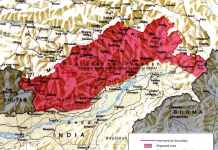The US’ lifting of restrictions on South Korean missiles could have security implications for the Korean peninsula. The move, coming in the wake of escalating China-US rivalry, could fuel further tensions in the Asia-Pacific, analysts say.
Communist North Korea led by Kim Jong-un has already hit back calling it Washington’s “shameful double-dealing”.
The 42-year old missile guidelines that imposed restrictions on the South Korean missile development system were lifted last month in the first summit between South Korean President Moon-Jae and his US counterpart President Biden.
The joint statement released called the summit developments “a new chapter in the alliance” and reaffirmed their “mutual commitment to the defense of the Republic of Korea and their combined defense posture under the ROK-U.S. Mutual Defense Treaty”.
The restrictions on the missile system date back to 1979 when South Korea signed a classified memorandum of understanding with the United States agreeing to limit its missile within a range of 180 kilometers and a 500-kilogram payload in exchange for acquiring US assistance in ballistic missile development.
How Weapons Curbs Were Eased
Since the Cold war, changes in the regional security structure have prompted South Korea to request for lifting some restrictions. Previously, the guidelines have been eased four times increasing the ballistic missile range from 180 kilometers to 300 and then further 800 kilometers.
In 2017, the US had scrapped the 500-kilogram warhead weight limit in lieu of North Korea’s sixth nuclear test. Last year in July 2020, the limit on the use of solid fuel in space launch vehicles (SLVs) was removed, giving a major boost to South Korea’s space industry.
“(The revision) will enable us to develop capabilities to launch low-orbit reconnaissance satellites, to establish ‘unblinking eye’ surveillance capabilities,” Kim Hyun-chong, the national security adviser to the President said.
Calling it “missile sovereignty”, President Moon reiterated the benefits of the move for the country’s aerospace industry. However, experts were quick to observe the far-reaching implications for South Korea’s military, intelligence, and security agencies.

The announcement has boosted the share prices of the key arms and aerospace manufacturers in the country. According to Stockholm International Peace Research Institute, South Korea is currently ranked 10th in the global arms export market with a share of 2.1%.
South Korea can now develop intermediate to long-range ballistic missiles capable of reaching targets beyond the Korean peninsula.
“We’ve developed a variety of missiles necessary for national security, and now we can develop any type of missiles as if an automobile company with a portfolio of compact cars would be able to develop bigger ones,” said Nam Se-gyu, a former head of the South Korean government’s Agency for Defense Development.
Analysts Raise Concern
Analysts have mooted a direct implication for the security stability of the Korean peninsula. South Korea’s traditional adversary North Korea criticized the development, calling it “disgusting, indecent.”
“The termination step is a stark reminder of the U.S. hostile policy toward the DPRK (the Democratic People’s Republic of Korea, the official name of North Korea) and its shameful double-dealing,” said Kim Myong Chol from the state’s mouthpiece KCNA news agency.
The Hyunmoo ballistic missile system and its variants have been developed specifically to deter North Korean threats.
In 2020, South Korea tested the Hyunmoo-4, suspected to have a payload of two tons, which was possible only after a revised guideline in 2017. Hyunmoo-2C is another such missile with an 800-kilometer range.
What experts fear the most is an arms race between the two rivals that will ultimately delay the peace process and a permanent solution that Moon and Biden addressed in their statement.
“South Korean missiles have a long way to go to rival those of the North, whose goal is to use them to send nuclear warheads as far as the United States, but skilled South Korean engineers may catch up sooner rather than later,” said Donald Kirk, a journalist covering North Korea since 1972, wrote in a piece for Foreign Policy.
The China Angle
Moreover, there is a belief that the move from Washington comes in the backdrop of a Sino-US rivalry. With the range restrictions lifted, South Korea has the capacity to hit targets as far as China, Japan and Russia.
Moon has virtually supported Biden’s policy of forming an anti-China alliance in the Indo-Pacific region, opined Park Yoon-bae, an analyst with The Korea Times.
South Korea has tacitly backed the US on the Taiwan issue, much to China’s discomfiture. Beijing claims the island as its territory and has hinted on several occasions that it would not hesitate to use force to assert its sovereignty on Taiwan.
Beijing also said it would not tolerate any foreign interference on the Taiwan issue, warning “relevant countries not to play with fire”.
Park Yoon-bae says South Korea should make efforts to “avoid any retaliation from Beijing as seen in the dispute over Seoul’s decision to allow Washington to deploy a missile defense system, known as THAAD, on our soil in 2017”.




